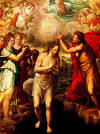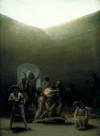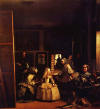100 Greatest Painters Artists Alphabetically Artists by Country Artists by Century Artists by Movement
Spanish Painting During the Inquisition
During the 1500s the church and monarchy in Spain were the primary patron of artists. According to Art Historian, Clara Erskine Clement Waters "Spanish painting had its birth during the reign of Ferdinand and Isabella, and may be said to have been derived from Italy, through the influence of the Italian painters who went to Spain, and the Spanish artists who made their studies in Italy. But in spite of this strong Italian influence Spanish painting has its own characteristics which separate it from all other schools, and give it a high position on its own merits." Painters were expected to create works that were in keeping with church doctrine. Paintings were also used to instruct illiterate people and help them understand Biblical stories and concepts. One of the most important influences upon early Spanish painters was their belief that the Virgin Mary, Jesus and other holy spirits guided them in their studios. Most studios had a small alter for frequent prayer and holy guidance.
The
Spanish
Inquisitors regularly inspected artist's paintings
to make sure they did not contain any devilish influences. If a painter
was found to be a bit free spirited in his interpretation of the
scriptures he would almost certainly find himself accused of
being a heretic or apostate. Once accused the artist was
subject to horrifying tortures until he confessed his sins. One of the
favored tortures especially reserved for artists was to have their eyes
slowly burned out with a hot poker so they could no longer ply their
trade. Others were simply were burned at the stake.
The Greatest Spanish Painters
Juan Fernandez Navarrete (1526-1579) Mannerist
Diego Velazquez (1599 - 1660) Baroque
Francisco Goya (1746 - 1828) Rococo
Bartolome Esteban Murillo 1617-1682 Baroque
Important Words, People, Phrases, Characteristics related to the Italian Renaissance Art Movement - rebirth, rediscovery of the classical world, City-state, Humanism, Humanist, Francesco Petrarch, Reform, The Prince, Theocracy, The Inquisition, Human Reasoning, Medici Academy, publication of Della Pittura, a book about the laws of mathematical perspective for artists, sfumato, chiaroscuro, linear perspective, Heliocentric Theory, Petrarch, Baldassare Castiglione, The Book of the Courtier, liberal arts, civic humanism, Verrocchio, secularism, Leonardo Bruni, Lorenzo Valla, Neo-Platonism, nominalism, Giotto, Masaccio, Botticelli, Quattrocento, vanishing point, Savonarola, oligarchy spiritually significant, illuminated manuscript, idealized biblical themes, scriptorium, emotion, illuminator, iconoclast, Michelangelo and Leonardo Da Vinci, Age of Discovery, axonometric drawing, curiosity about the natural world, mythology, realistic use of colours and light, Bonfire of the Vanities, Old Testament stories, ethereal and foggy backgrounds, Gospel parables, The Blackdeath, romanticized landscapes, Christian symbolism. Paradise
☼☼☼☼☼
If you feel you have worthwhile information you would like to contribute we would love to hear from you. We collect essential biographical information and artist quotes from folks all over the globe and appreciate your participation. When submitting please, if possible, site the source and provide English translation. Email to historyofpainter@gmail.com
© HistoryofPainters.com 2017
If you like this page and wish to share it, you are welcome to link to it, with our thanks.
Popular Questions About Renaissance Art History
What is the difference between Italian Renaissance art and Northern Renaissance art?
How did the Black Death impact European art history?
How did the Inquisition impact European art history?
What was the influence of the Medici Academy on Renaissance painters?
What was the Bonfire of the Vanities?
Who were the greatest painters of the Renaissance?



